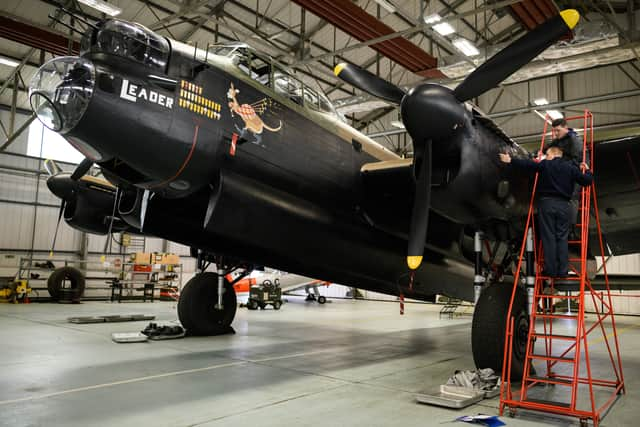Dambusters raid: 80th anniversary flypast route and timings - 2023 Lancaster bomber memorial flight explained
and live on Freeview channel 276
To commemorate the 80th anniversary of the Dambusters raids, a Lancaster bomber has flown over the Lincolnshire RAF airfields that were used during World War II.
On the evenings of 16 and 17 May 1943, the infamous raids were undertaken from RAF Scampton in Lincolnshire. To honour the risky assaults on German dams, the Battle of Britain Memorial Flight (BBMF) planes toured 28 former Bomber Command locations on Tuesday (16 May).
Advertisement
Hide AdAdvertisement
Hide AdThe BBMF Lancaster PA474 completed a 69-minute tour of all of Bomber Command's former airfields, departing from Spitalgate at 18:58 BST and arriving at its base at RAF Coningsby at 20:07 BST. Here is everything you need to know about it.
What were the Dambuster raids?
The Dambuster raids, officially known as Operation Chastise, were a series of World War II air attacks conducted by the RAF during World War II that targeted several dams in Germany's industrial heartland.
Their purpose was to cripple German industrial production by severely damaging key dams. The idea was to disrupt the supply of water to industries and power stations, as well as flood agricultural land, causing significant disruption to the German war effort.


The raids were carried out by No. 617 Squadron, a specially formed unit which used modified Avro Lancaster bombers equipped with a revolutionary "bouncing bomb". The bomb, officially known as the Upkeep bomb, was specifically developed to skip across the water and then sink before detonating next to the dam, causing maximum damage.
Advertisement
Hide AdAdvertisement
Hide AdOn the night of the raid, 19 Lancaster bombers took off from RAF Scampton. They faced numerous challenges, including difficult flying conditions, intense anti-aircraft fire and enemy fighter opposition. Despite these obstacles, they successfully breached the Möhne and Eder dams, causing significant destruction and flooding downstream.
The raids were considered a remarkable feat of precision bombing and showcased the ingenuity and bravery of the RAF pilots involved. However, the success came at a high cost, with eight aircraft lost and 53 aircrew killed. The raids inflicted significant damage on the targeted dams, but the overall impact on German industrial production was less than initially hoped for.
While the Dambuster raids remain one of the most famous and celebrated operations of World War II, and have been the subject of books, documentaries and the popular 1955 film, they killed an estimated 1,300 people, largely civilians. Entire communities were flooded, and infrastructure such as roads, railways, and buildings were severely damaged or destroyed.
The civilian casualties included workers at industrial facilities and power stations, as well as residents living in the affected areas. The raids also disrupted the water supply to many communities, which further compounded the hardships faced by the local population.
Dambuster flypast tour route and timings
Advertisement
Hide AdAdvertisement
Hide AdOut of the 7,377 Lancaster bombers manufactured, PA474 is one of just two still flying. At 18:01 BST on 17 May 2023, the plane flew over the RAF Museum in Hendon, northwest London, to mark the occasion before making its way back to Lincolnshire for the tour.
(All times BST)
Spitalgate - 18:58
Fulbeck - 19:02
Swinderby - 19:04
RAF Waddington - 19:07
International Bomber Command Centre (IBCC), Lincoln - 19:08
Skellingthorpe - 19:12
Scampton - 19:15
Dunholme - 19:16
Wickenby - 19:18
Faldingworth - 19:19
Ingham - 19:21
Hemswell Cliff - 19:22
Blyton - 19:24
Elsham Wolds - 19:30
Kirmington - 19.31
North Killingholme - 19:32
Grimsby - 19:37
Binbrook - 19:39
Ludford - 19:41
Kelstern - 19:42
Strubby - 19.47
Spilsby - 19.51
East Kirkby - 19:53
Bardney - 19:58
Fiskerton - 20:00
Metheringham - 20:03
Woodhall Spa - 20:05
RAF Coningsby - 20:07
Lancaster PA474 is a four-engine heavy bomber built by Victory Aircraft in Canada. Although it was manufactured in 1945 toward the end of the war, it did not see active service during the conflict.
In 1964, the aircraft was selected to join the newly formed BBMF, and was modified to simulate the appearance and role of the Lancaster bombers used in the Dambuster raids - including the installation of a bouncing bomb cradle. None of the aircraft that participated in the Dambuster raids have survived to the present day.
Comment Guidelines
National World encourages reader discussion on our stories. User feedback, insights and back-and-forth exchanges add a rich layer of context to reporting. Please review our Community Guidelines before commenting.
